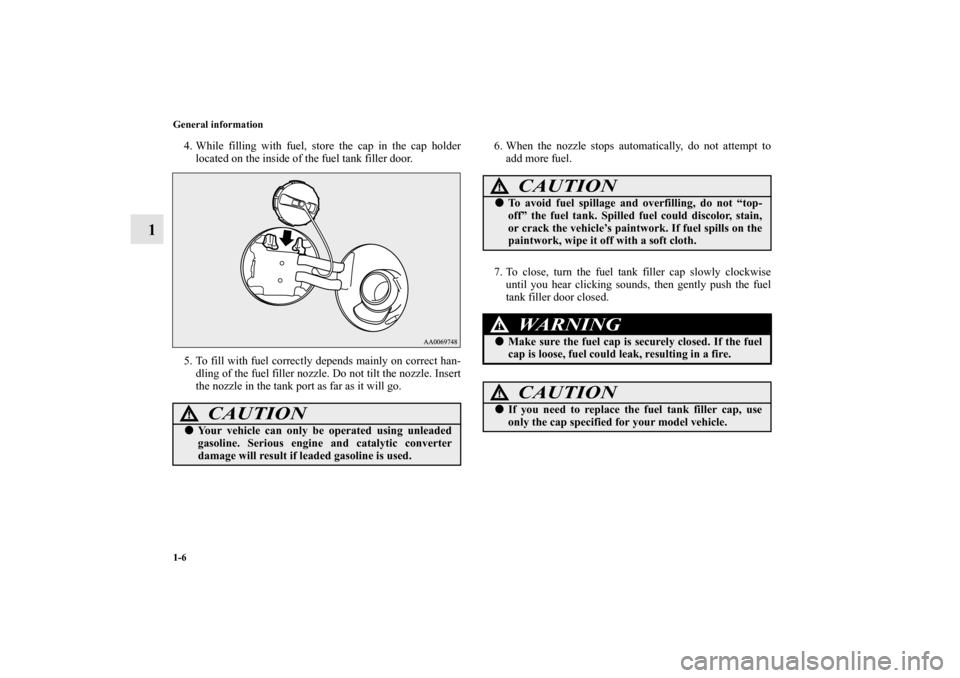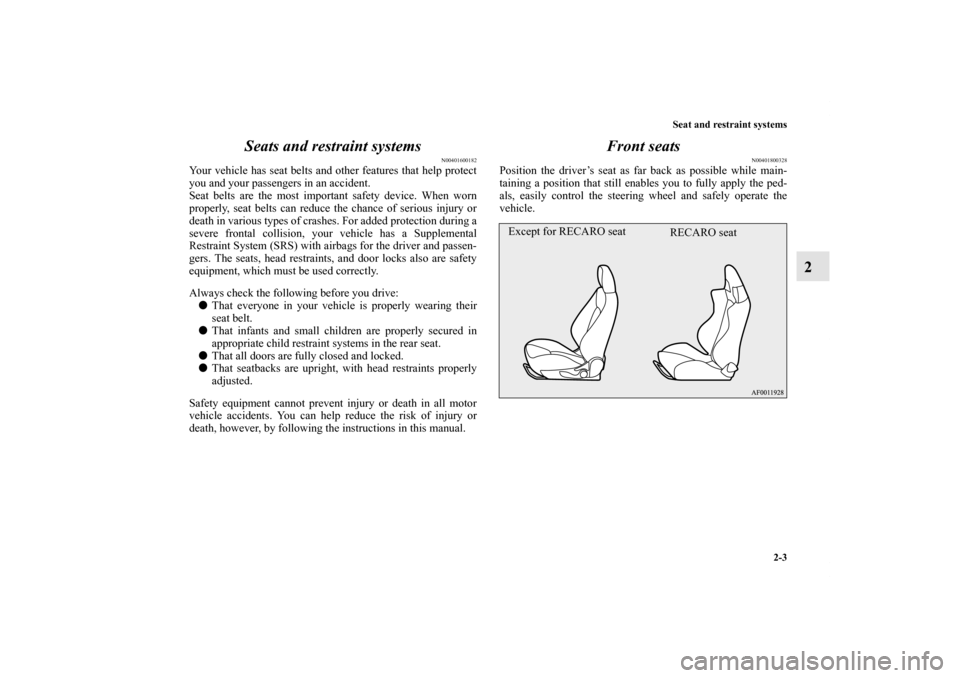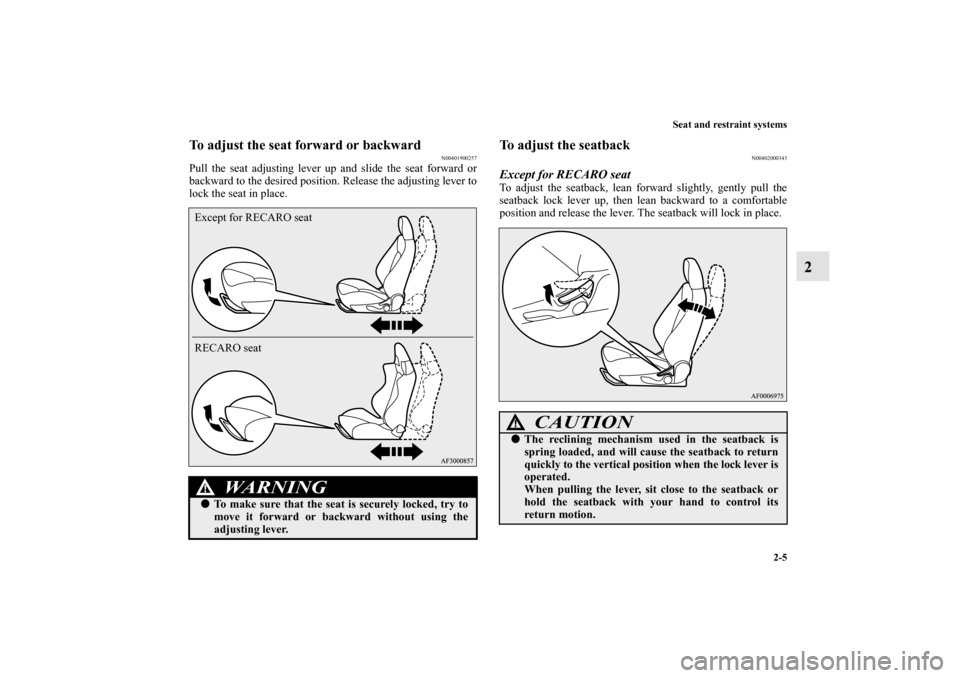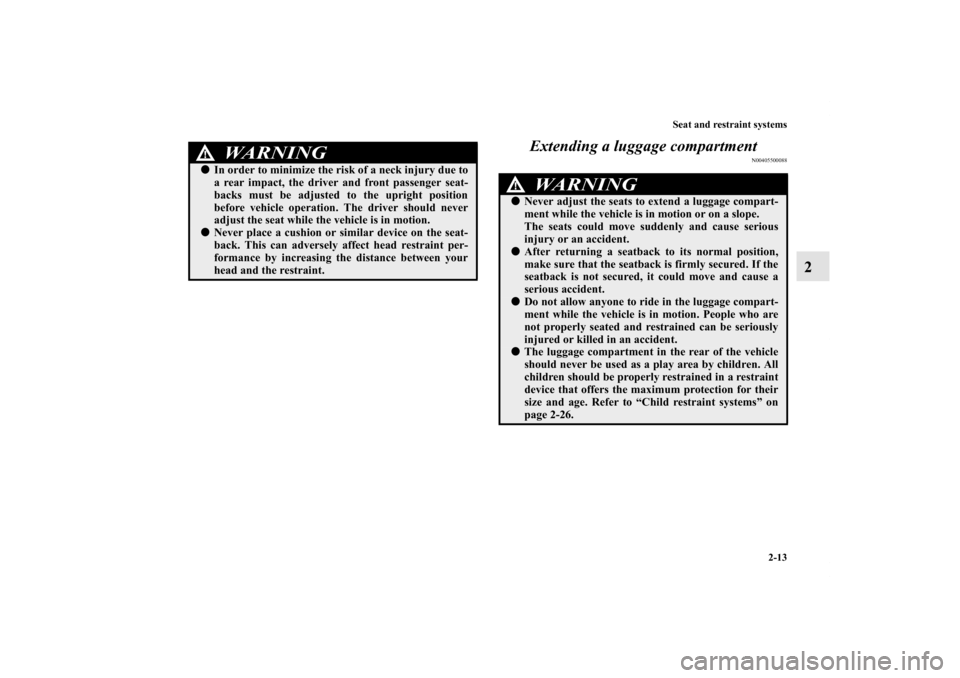Page 10 of 706

Overview
Outside (Front)
N00100601323
Sunroof (if so equipped) P.3-73
Windshield wiper P.3-242
Engine compartment
P. 7 - 7
Engine hood P.7-4
Headlights, high beam P.3-230, 7-56, 7-62 Daytime running lights P.3-230, 7-56, 7-65 [For vehicles with high intensity discharge headlights type]
Front side-marker and
parking lights
P.3-230, 7-56, 7-69 Outside rearview mirrors P.3-83
Fuel tank filler P.1-4
Side turn signal lights P.3-239, 7-56Locking and unlocking P.3-52
Keyless entry system
(if so equipped) P.3-8
F.A.S.T.-key (Free-hand Advanced
Security Transmitter)
(if so equipped) P.3-16
Front fog lights (if so equipped) P.3-241, 7-56, 7-73
[Except for vehicles with high intensity discharge
headlights type]
Front turn signal lights P.3-239, 7-56, 7-71
Front turn signal lights P.3-239, 7-56, 7-71
Headlights, low/high beam
P.3-230, 7-56, 7-67
Front side-marker and
parking lights
P.3-230, 7-56, 7-67 Headlights, low beam
P.3-230, 7-56, 7-60
BK0151000US.book 8 ページ 2012年3月29日 木曜日 午後6時8分
Page 25 of 706

1-6 General information
1
4. While filling with fuel, store the cap in the cap holder
located on the inside of the fuel tank filler door.
5. To fill with fuel correctly depends mainly on correct han-
dling of the fuel filler nozzle. Do not tilt the nozzle. Insert
the nozzle in the tank port as far as it will go.6. When the nozzle stops automatically, do not attempt to
add more fuel.
7. To close, turn the fuel tank filler cap slowly clockwise
until you hear clicking sounds, then gently push the fuel
tank filler door closed.
CAUTION
!�Your vehicle can only be operated using unleaded
gasoline. Serious engine and catalytic converter
damage will result if leaded gasoline is used.
CAUTION
!�To avoid fuel spillage and overfilling, do not “top-
off” the fuel tank. Spilled fuel could discolor, stain,
or crack the vehicle’s paintwork. If fuel spills on the
paintwork, wipe it off with a soft cloth.
WA R N I N G
!�Make sure the fuel cap is securely closed. If the fuel
cap is loose, fuel could leak, resulting in a fire.
CAUTION
!�If you need to replace the fuel tank filler cap, use
only the cap specified for your model vehicle.
BK0151000US.book 6 ページ 2012年3月29日 木曜日 午後6時8分
Page 32 of 706

Seat and restraint systems
2-3
2 Seats and restraint systems
N00401600182
Your vehicle has seat belts and other features that help protect
you and your passengers in an accident.
Seat belts are the most important safety device. When worn
properly, seat belts can reduce the chance of serious injury or
death in various types of crashes. For added protection during a
severe frontal collision, your vehicle has a Supplemental
Restraint System (SRS) with airbags for the driver and passen-
gers. The seats, head restraints, and door locks also are safety
equipment, which must be used correctly.
Always check the following before you drive:
�That everyone in your vehicle is properly wearing their
seat belt.
�That infants and small children are properly secured in
appropriate child restraint systems in the rear seat.
�That all doors are fully closed and locked.
�That seatbacks are upright, with head restraints properly
adjusted.
Safety equipment cannot prevent injury or death in all motor
vehicle accidents. You can help reduce the risk of injury or
death, however, by following the instructions in this manual.
Front seats
N00401800328
Position the driver’s seat as far back as possible while main-
taining a position that still enables you to fully apply the ped-
als, easily control the steering wheel and safely operate the
vehicle.Except for RECARO seat
RECARO seat
BK0151000US.book 3 ページ 2012年3月29日 木曜日 午後6時8分
Page 33 of 706

2-4 Seat and restraint systems
2
WA R N I N G
!�Do not attempt to adjust the seat while driving. This
can cause loss of vehicle control and result in an
accident.�After adjusting the seat, make sure that the seat is
securely locked into position.�To reduce the risk to the driver of serious injury or
death during deployment of the driver’s airbag,
always properly wear the seat belt and adjust the
driver’s seat as far back as possible while maintain-
ing a position that still enables you to fully apply the
pedals, easily control the steering wheel, and safely
operate the vehicle.�To reduce the risk to the front passenger of serious
injury or death during deployment of the passen-
ger’s airbag, always properly wear the seat belt and
adjust the front passenger’s seat as far back as pos-
sible.�Always place children 12 years old and under in the
rear seat and use appropriate child restraint sys-
tems.
CAUTION
!�Make sure that the seat is adjusted by an adult. If it
is adjusted by a child, an unexpected accident might
occur.�Do not place a cushion or the like between your back
and the seatback while driving. The effectiveness of
the head restraints will be reduced in the event of an
accident.�When sliding the seats, be careful not to catch your
hand or leg.�When sliding or reclining the seat rearward, pay
careful attention to the rear seat passengers.
BK0151000US.book 4 ページ 2012年3月29日 木曜日 午後6時8分
Page 34 of 706

Seat and restraint systems
2-5
2
To adjust the seat forward or backward
N00401900257
Pull the seat adjusting lever up and slide the seat forward or
backward to the desired position. Release the adjusting lever to
lock the seat in place.
To adjust the seatback
N00402000343
Except for RECARO seatTo adjust the seatback, lean forward slightly, gently pull the
seatback lock lever up, then lean backward to a comfortable
position and release the lever. The seatback will lock in place.
WA R N I N G
!�To make sure that the seat is securely locked, try to
move it forward or backward without using the
adjusting lever. Except for RECARO seat
RECARO seat
CAUTION
!�The reclining mechanism used in the seatback is
spring loaded, and will cause the seatback to return
quickly to the vertical position when the lock lever is
operated.
When pulling the lever, sit close to the seatback or
hold the seatback with your hand to control its
return motion.
BK0151000US.book 5 ページ 2012年3月29日 木曜日 午後6時8分
Page 42 of 706

Seat and restraint systems
2-13
2 Extending a luggage compartment
N00405500088
WA R N I N G
!�In order to minimize the risk of a neck injury due to
a rear impact, the driver and front passenger seat-
backs must be adjusted to the upright position
before vehicle operation. The driver should never
adjust the seat while the vehicle is in motion.�Never place a cushion or similar device on the seat-
back. This can adversely affect head restraint per-
formance by increasing the distance between your
head and the restraint.
WA R N I N G
!�Never adjust the seats to extend a luggage compart-
ment while the vehicle is in motion or on a slope.
The seats could move suddenly and cause serious
injury or an accident.�After returning a seatback to its normal position,
make sure that the seatback is firmly secured. If the
seatback is not secured, it could move and cause a
serious accident.�Do not allow anyone to ride in the luggage compart-
ment while the vehicle is in motion. People who are
not properly seated and restrained can be seriously
injured or killed in an accident.�The luggage compartment in the rear of the vehicle
should never be used as a play area by children. All
children should be properly restrained in a restraint
device that offers the maximum protection for their
size and age. Refer to “Child restraint systems” on
page 2-26.
BK0151000US.book 13 ページ 2012年3月29日 木曜日 午後6時8分
Page 43 of 706

2-14 Seat and restraint systems
2
NOTE�When the seatback of a front seat is reclined, return it to
the upright position before driving.
Folding the rear seatbacks forward
N00405700093
The rear seatbacks can be folded forward to extend luggage
compartment.NOTE�Before folding the rear seatbacks forward, make sure that
the arm rest is stowed and the head restraints are lowered
completely.
�You can separately fold the right and left side of the seat-
back.
1. Push the rear seat release button (A) to manually fold the
rear seatback forward, or pull the luggage compartment
lever (B) to automatically fold the seatback forward.
�The front passenger seat is equipped with weight
sensors. Depending on the weight detected, the front
passenger airbag is disabled or enabled. When fold-
ing the rear seats forward for increased cargo
capacity, the front passenger seat and seatback must
be adjusted to assure they are not contacting the
rear seat. In the event the front seat or seatback is
allowed to contact the folded rear seat, proper oper-
ation of the front passenger airbag system may be
affected.
CAUTION
!�In the luggage compartment, do not load the luggage
higher than the top of the seats and make sure that
the luggage is firmly secured. Restricted rear vision
or unsecured objects entering the passenger com-
partment from the luggage compartment during
sudden braking can cause serious injury or an acci-
dent.�Seatbacks should always be folded and put back into
normal position by an adult. Seat adjustments by a
child could lead to an unexpected accident.�When adjusting the seats, be careful not to catch
your hand or leg. Personal injury could result.
WA R N I N G
!
Rear seat release buttons
BK0151000US.book 14 ページ 2012年3月29日 木曜日 午後6時8分
Page 44 of 706
Seat and restraint systems
2-15
2
2. The seatbacks fold forward.
Confirm that the seatback locks securely when it is
returned.
Luggage compartment levers
WA R N I N G
!�When folding the rear seat, make sure no one is on
the seat. The seatback will fall forward rapidly and
could cause serious injury.�After returning the seatbacks to their upright posi-
tions, make sure that the seatbacks lock in place and
are firmly secured.
Also check to be sure that the rear seat belts are in
front of the seatbacks, and not caught behind the
seatbacks.
BK0151000US.book 15 ページ 2012年3月29日 木曜日 午後6時8分